Vegetation Index
An index derived from drone-based multispectral imaging to assess plant health, commonly used in agriculture.
The health of our planet’s ecosystems is of paramount importance, particularly in agriculture, where crop vitality directly influences food security and economic stability. Technological advancements have enhanced our ability to monitor and evaluate plant health through sophisticated methods. Understanding terms like "Vegetation Index" is essential for anyone involved in environmental research, agriculture, or land management, as it encapsulates a key metric that informs decision-making and sustainability practices.
What is Vegetation Index?
The Vegetation Index is an analytical metric derived from drone-based multispectral imaging, specifically designed to assess the health of plants. By capturing light reflected from vegetation, this index provides insights into plant conditions, such as vigor and stress levels. It helps farmers and agronomists understand how well their crops are growing, and can also detect issues like water stress or nutrient deficiencies even before they're visible to the naked eye.
Key Concepts
Multispectral Imaging: Technology that captures light from multiple wavelengths, allowing for more detailed analysis of plant health compared to standard imagery.
Reflectance Values: Measurements of light reflected from plant surfaces, which vary based on species, health, and conditions.
Normalized Difference Vegetation Index (NDVI): One of the most commonly used indices, calculated using the difference between near-infrared and red light reflectance, indicating the presence and condition of vegetation.
Crop Health Monitoring: Utilization of Vegetation Index to regularly track and optimize crop performance, leading to enhanced yields.
Applications and Relevance
Precision Agriculture: Farmers use Vegetation Index data to apply water, fertilizers, and pesticides only where needed, optimizing resource use and reducing costs.
Yield Prediction: By assessing plant health throughout the growing season, producers can better estimate harvest yields.
Environmental Conservation: Conservationists can monitor ecosystems and track changes in species health or biodiversity over time.
Disaster Management: Using Vegetation Index data to assess crop damage post-natural disasters helps in formulating response strategies.
Challenges and Considerations
Data Management: Collecting and processing large volumes of multispectral images can be complex and requires specialized software and skills.
Variability in Results: Factors such as soil type, moisture levels, and atmospheric conditions can influence reflectance values, potentially affecting accuracy.
Cost of Technology: High-quality drones and imaging equipment can be expensive, which may limit access for smaller operations.
Training Needs: Users must be trained to interpret Vegetation Index data accurately, which can be a barrier for widespread adoption.
Future Trends and Innovations
Integration with AI: The incorporation of artificial intelligence and machine learning algorithms to analyze Vegetation Index data more efficiently and accurately.
Real-Time Monitoring: Continuous advancements in drone technology are leading to the possibility of real-time data collection and analysis for faster decision-making.
Enhanced Algorithms: Development of more refined algorithms that improve the precision of Vegetation Index calculations across diverse conditions.
Interdisciplinary Applications: Expanding the use of Vegetation Index beyond agriculture to urban planning, forestry, and climate studies.
In summary, the Vegetation Index stands at the forefront of agricultural technology and ecological monitoring. Its ability to provide timely, detailed insights into plant health not only supports farmers in improving crop management but also plays a significant role in broader environmental stewardship. As it continues to evolve with technological advancements, understanding and leveraging this index will be vital for addressing challenges in food production, sustainability, and ecological preservation.














